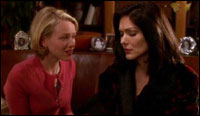| |
 |
|
|
Such a reading, however, does not acknowledge
Mulholland Drive’s ambivalence and self-reflexivity
as it does not recognise Lynch’s humanism. Mulholland Drive
is a tragedy. Diane is a victim. She is warped and destroyed
by a Hollywood primarily characterised as masculinist. Women
are demonised by Hollywood and pathological femininity is
formed culturally. Lynch is acutely aware of Hollywood iconography
and narratives which fashion the bodies, dress and destinies
of its actresses. Thus, Mulholland Drive can be enjoyed
as a post-modern, feminist comment upon the wonderful and
twisted career of women in the city of Angels. Lynch humanises
the Hollywood murderess. Firstly, superficially, Betty/Diane
does not look like a classic film noir anti-heroine. It is
Rita/Camilla - Diane’s victim - who looks more like the real
thing. Betty’s dress, her neatly cut blue-grey skirt and jacket
which she wears when trespassing Diane Selwyn’s apartment
and her probing manner manifest Lynch’s interest in Hitchcockian
heroines (such as the kind played be Tippy Hedren and Eva
Marie Saint in The Birds (1963) and North by
North West (1959) respectively). Diane’s style and
manner do not denote a pure homage to Hitchcock. Lynch perhaps
alludes to Hitchcock’s misogyny and recognises Hollywood’s
textual violence against women. In Mulholland, Betty
is punished for her transgression. Entering the apartment,
she discovers her own corpse, the corpse of course of Diane.
For Lynch, Diane is ultimately a tragic character destroyed
by her Hollywood dream like an abused starlet of old. Women
in Lynch’s Hollywood mutate and fragment. Their identities
are dangerously fluid. Their images are prostituted. A diversity
of female faces are given the same name. The likenesses of
actresses, prostitutes and waitresses allude to multi-narratives
of exploitation. Although he celebrates the power of performance
and the wonder of self-invention, Lynch’s Hollywood manifest
the awful interchangeability of the actress as it highlights
its reduction of women to her sexual exchange value. The actress
is the artificial product par excellence as her body, hair,
nose, breasts are transmogrified. Her sexuality may be bought
and sold. Camilla’s promiscuity is only characteristic of
this soul-less market of luxuriant bodies. Diane’s decline
is due to her lack of sexual and professional desirability.
Women in Lynch’s Hollywood are of often fearful of each other.
Louise Bonner and Coco believe Rita to be trouble. Older women
patronise younger women. Finally, his female lovers are estranged
from each other. It is Hollywood which is the source of female
alienation. The mental and physical decline of Diane therefore
mirrors a particular culturally-constructed female suffering.
The blackest image of Mulholland is the freakish, hallucinatory
portend of the tramp. I suggest that the monstrous tramp is
perhaps for Diane a nightmarish image of herself. Prefiguring
absolute degradation and death itself, the creature is a hellish,
mythic double of herself. The ingenue, the Girl from Deep
River, Ontario dreams of becoming the monstrous bag lady.
The tramp is apparently of indeterminate sex and has been
identified by many as male. Yet it is a surreal possibility
that a woman dehumanised by Hollywood is unsexed by her decline.
The tramp is played by a woman (Bonnie Aarons) and she surreally
haunts the diner of the archetypal cast-off actress. The tramp
is a monstrous and feminine figure. What further identifies
the creature as a woman is the witch-like face. For the surrealists,
the medieval figure of the witch is essentially feminine.
The surrealists may associate her with transgression but the
witch, undoubtedly is a regressive image. She is imprinted
with immanence and evil. Lynch, however, transforms this surreal
image. The awful figure represents tragic femininity. In Hollywood,
an aspiring actress may negotiate a hellish downward dream-like
spiral from waitress to junkie prostitute to grotesque vagrant.
The surreal links are tragic. The solitary, corpse-like woman
of Silencio who closes Mulholland Drive is also
a camp and surreal figure who also haunts the tragic Diane.
A ghastly apparition, she too signifies female degeneration.
|